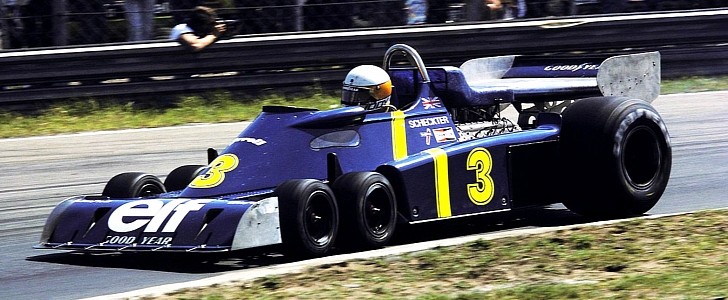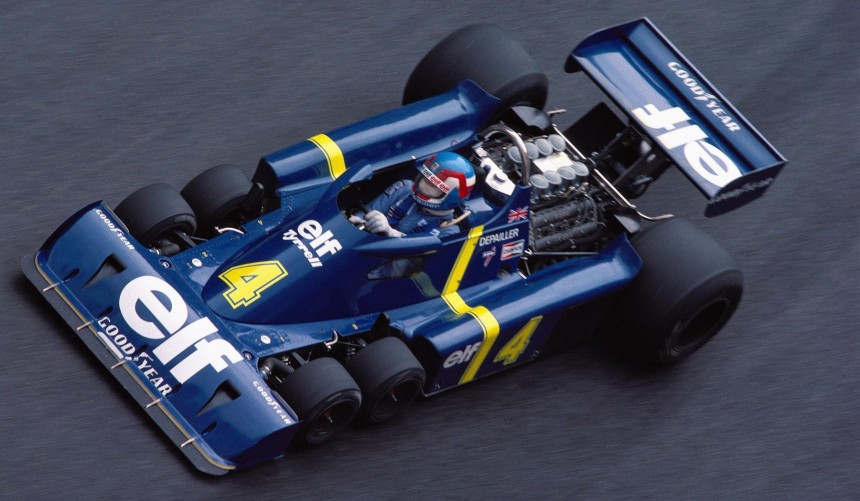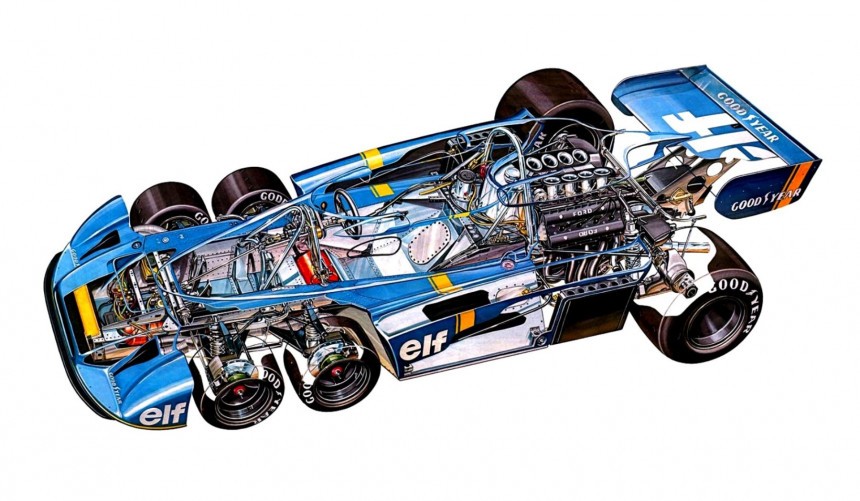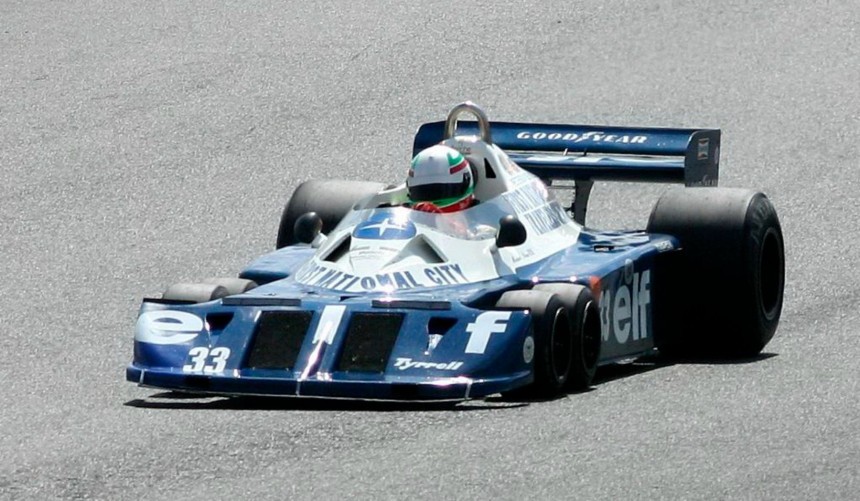When you think about six-wheeled vehicles the first thing that springs to mind is a truck, the next will probably be the Mercedes-Benz G63 AMG 6X6, and by no means will an open-wheeler follow. However, such an insane vehicle existed, and it actually competed in official Formula 1 races 45 years ago.
The world of motorsport has always been a launching pad for automotive innovations. Some of the most revolutionary technologies were pioneered in Formula 1, arguably the most important racing championship in the world.
Between 1965 and 1975, the leading innovators in the competitions were Lotus and Brabham, who won a total of seven constructors' titles during that period. A third British team named Tyrell was also very successful, managing to grab three driver's championships in 1969, 1971, and 1973 thanks to the legendary Jackie Stewart. He also helped them win the 1971 constructors' trophy.
One of the men responsible for Tyrell's success was Derek Gardner, a respected designer who built the team's first chassis at home in his garage back in 1970. The man gained a reputation for thinking outside the box, and in 1975, he would blow people's minds with the next iteration of Tyrell's race car.
It all started with the Formula 1 rules of the era stipulated that the maximum width for the front wing should not exceed 1.5 meters (4.9 feet). With the required room for the driver's feet and the steering and suspension systems, the front wheels stuck out to the sides of the wing, which affected the car's overall airflow. Narrower wheels were not an option, so Gardner started experimenting with smaller-diameter variants that would help increase aerodynamic efficiency.
However, due to the space limitations the only design he could come up with that would fit entirely behind the wing measured 250 mm (10 inches) in diameter, tires included. The contact patch they offered was just too small for optimum cornering performance, but the forward-thinking designer didn't give up and came up with a brilliant solution. After studying the Formula 1 rulebook, he noticed that there was no mention of the maximum number of wheels required, so he simply fitted another pair to the front of the car.
While this added weight and complexity to the overall design, the aerodynamic gains were significant. One initial problem was the steering system, but Gardner and his team solved it by connecting the rear set to the front with a bell crank. This was another great idea with drivers reporting that the steering was so sharp yet gentle that it was comparable to a power-assisted system.
Dubbed P34 and powered by a Ford-Cosworth V8, the innovative race car was unveiled at the Heathrow Hotel in late September 1975. Those in attendance were astonished to see six wheels instead of the conventional four, and many were convinced that it was purely a publicity stunt.
It was taken to the track for the first time in October, at Silverstone and after a few more tests, Tyrell decided to build two more, slightly longer wheelbase versions for the 1976 season. Driven by Jody Scheckter and Patrick Depailler, these stretched versions debuted at the Spanish Grand Prix, the fourth race on the calendar, and proved to be competitive.
Three rounds later, in Sweden, Scheckter and Depailler finished first and second, much to everyone’s amazement. To this day, the South African is the only Formula 1 driver to ever win a Grand Prix driving a six-wheel single-seater.
In the nine races that followed, the P34s earned twelve additional podium finishes, helping Tyrell finish third in the Constructor’s standings, after Ferrari and McLaren.
With several revisions, the six-wheeled racer now called P34B returned for the 1977 season. Although aerodynamically refined, it was heavier than its predecessor, which led to poor results. In November, the team revealed a new chassis with a conventional layout for 1978, closing the door on the six-wheel project.
March Engineering, Williams, and Ferrari would also experiment with six-wheel designs in the following years, but all of these test cars featured two sets at the back and never entered an official race. FIA banned cars with four driven wheels from competing in 1983 and eventually, Formula 1 regulations would require a maximum of four wheels to be used.
Although it had a short-lived career and never managed to bring Tyrell any titles, the P34 is still considered one of the most radical designs in the history of motorsport, 45 years after its racing debut.
Below, you can watch an awesome onboard video posted on YouTube by RacingSport34. The footage is from a 1977 practice lap at Monaco where Patrick Depailler drives a semi-disassembled P34B showcasing its four-wheel steering.
Between 1965 and 1975, the leading innovators in the competitions were Lotus and Brabham, who won a total of seven constructors' titles during that period. A third British team named Tyrell was also very successful, managing to grab three driver's championships in 1969, 1971, and 1973 thanks to the legendary Jackie Stewart. He also helped them win the 1971 constructors' trophy.
One of the men responsible for Tyrell's success was Derek Gardner, a respected designer who built the team's first chassis at home in his garage back in 1970. The man gained a reputation for thinking outside the box, and in 1975, he would blow people's minds with the next iteration of Tyrell's race car.
However, due to the space limitations the only design he could come up with that would fit entirely behind the wing measured 250 mm (10 inches) in diameter, tires included. The contact patch they offered was just too small for optimum cornering performance, but the forward-thinking designer didn't give up and came up with a brilliant solution. After studying the Formula 1 rulebook, he noticed that there was no mention of the maximum number of wheels required, so he simply fitted another pair to the front of the car.
While this added weight and complexity to the overall design, the aerodynamic gains were significant. One initial problem was the steering system, but Gardner and his team solved it by connecting the rear set to the front with a bell crank. This was another great idea with drivers reporting that the steering was so sharp yet gentle that it was comparable to a power-assisted system.
It was taken to the track for the first time in October, at Silverstone and after a few more tests, Tyrell decided to build two more, slightly longer wheelbase versions for the 1976 season. Driven by Jody Scheckter and Patrick Depailler, these stretched versions debuted at the Spanish Grand Prix, the fourth race on the calendar, and proved to be competitive.
Three rounds later, in Sweden, Scheckter and Depailler finished first and second, much to everyone’s amazement. To this day, the South African is the only Formula 1 driver to ever win a Grand Prix driving a six-wheel single-seater.
In the nine races that followed, the P34s earned twelve additional podium finishes, helping Tyrell finish third in the Constructor’s standings, after Ferrari and McLaren.
March Engineering, Williams, and Ferrari would also experiment with six-wheel designs in the following years, but all of these test cars featured two sets at the back and never entered an official race. FIA banned cars with four driven wheels from competing in 1983 and eventually, Formula 1 regulations would require a maximum of four wheels to be used.
Although it had a short-lived career and never managed to bring Tyrell any titles, the P34 is still considered one of the most radical designs in the history of motorsport, 45 years after its racing debut.
Below, you can watch an awesome onboard video posted on YouTube by RacingSport34. The footage is from a 1977 practice lap at Monaco where Patrick Depailler drives a semi-disassembled P34B showcasing its four-wheel steering.





